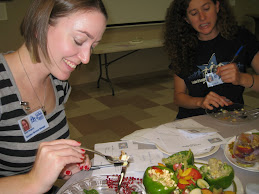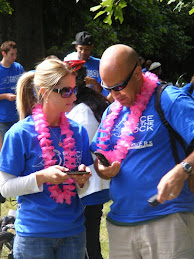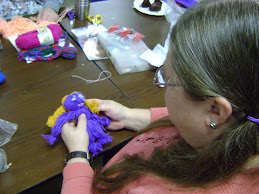Sacramento Food Bank & Family Services (SFBFS) is lucky to have more than 6,000 volunteers every year. In addition, our Youth Education program offers a significant number of internships to students interested in learning more about the organization and giving back to their community. The students served in a variety of different roles this summer including Office assistant, database entry, Playcare assistant, Summer Camp assistant and more.
As the summer comes to an end, some of our interns reflected on their experience and what they learned here this summer at SFBFS. Read their stories:
Aaron
Amy
Beatriz
Carmen
Charlessa
Henry
Izzy
JT
Leena
Lesslie
Marc
Mary Angela
Nikki
Tori-Victoria
We could not do what we do without the dedicated individuals who give their time to support SFBFS. We are thankful for the interns we had this summer and hope their experiences here will stay with them for a lifetime.
Are you interested in being a part of the SFBFS family? Contact Aurelia Garcia, agarcia@sacramentofoodbank.org for internship opportunities.
Submitted by: Aurelia Garcia, Youth Education Program Manager & Counselor
August 10, 2015
July 27, 2015
What Can I Eat?
Along with summer comes summer camp here at Sacramento Food
Bank & Family Services. Once a week I get kids from the first through sixth
grade for an hour of garden activities. It takes some time to figure out
what I should do with this diverse crowd in the garden. The older kids
like games while the younger kids like touching, tasting and generally making a
fun mess. I’m wary of letting the younger ones pick veggies since they
tend to stray off paths and pull half a plant up. I have to be conscious
with the older ones because they’ve started forming clusters and don’t willingly
leave their friend group. So the goal of a kids’ gardening class: let
kids explore healthy eating, gardening and science while keeping plants whole
and monitoring the emotions and actions of potentially warring factions.
Sure, super easy. After a couple years, I’ve established a criteria for what
happily occupies kids in the garden. The criterion follows:
For lower grades:
- Dirty is better. Paint, mud, markers are great. Spilling everything onto unprotected surfaces? Even better.
- Have edible things on hand. Younger kids generally have one question for me “WHAT CAN I EAT?”
- Competitive games are the best. Does it involve running, accidentally smacking into each other and the glory of winning? They are all about it.
- Feeding the fish. These kids like responsibility and being a part of the process. Give them some fish food and away they go (applicable to other things involving responsibility).
All kids: Eating strawberries! When all else fails, direct
them to the strawberry patch. Jokes aside, it’s a joy having youth in the garden and
showing them plants or foods they have never seen or eaten. Kids get so
excited in a way that you rarely see in adults and they remind me how the
garden and all the living things inside of it are magical and exciting!
Submitted by: Kate Wilkins, Garden Coordinator
Submitted by: Kate Wilkins, Garden Coordinator
June 29, 2015
Insight into ESL
My name is Phoebe Neuburger and I am a Global
Studies student in my senior year at Whittier College in Los Angeles. This summer
I was able to do my internship in Adult Education and in Refugee Resettlement
Services at Sacramento Food Bank & Family Services (SFBFS). Volunteer
service at SFBFS is a tradition in my family. Last summer I enjoyed
volunteering at a food distribution and also in SFBFS’ Youth Education summer
camp working with young kids. My mom volunteers as a tutor in the evenings in Adult
Education where she helps students prepare for the GED exam. I joined my mom
one evening last summer and I remember I really liked it. The feeling of
helping others gave me a sense of purpose and I enjoyed the feeling. I was
hoping my internship at SFBFS would give me a better idea of what I might want
to do in my life in relation to helping people.
My internship at SFBFS has been a truly memorable experience. I was able to observe and participate in (sometimesJ) the advanced level ESL class. The ESL classes offer students an opportunity to learn and/or improve their English language speaking, reading and writing skills. The advanced class offer adults the opportunity to improve their English fluency and advance to better jobs or community college. I was able to observe and interact with a diverse group of adults and it was amazing to see how motivated every student is about accomplishing their goals. Everyone has a unique story of how he or she arrived in the U.S.
My internship at SFBFS has been a truly memorable experience. I was able to observe and participate in (sometimesJ) the advanced level ESL class. The ESL classes offer students an opportunity to learn and/or improve their English language speaking, reading and writing skills. The advanced class offer adults the opportunity to improve their English fluency and advance to better jobs or community college. I was able to observe and interact with a diverse group of adults and it was amazing to see how motivated every student is about accomplishing their goals. Everyone has a unique story of how he or she arrived in the U.S.
I have heard English is one of the hardest
languages to learn, especially when you are an adult. All the students I met
were enthusiastic and grateful learners. I was adopted from Vietnam as an
infant and the ESL students reminded me of how much easier it is to learn
English as a small child. I was lucky to have been young enough to learn
English as a young person compared to immigrants who come from different
countries and learn English as adults. As a young girl I tried pushing myself
to learn English but even so, I soon lost interest and wanted to give up. The
ESL students I met have inspired me and helped me see what I could improve in
my own life and helped me to reflect on myself and my future. Many of the students
are parents learning English for themselves, but also for their children.
Without sharing a common language with your community, life is much harder.
The advanced ESL class that I observed was taught
by a friendly, enthusiastic teacher named Stuart Schulz. He is a high-energy
and funny teacher in every class he teaches. He was joking and laughing with
his students and I could see the close bond between teacher and student. I
saw how the classroom did not have to be a serious learning environment all the
time. I liked the relaxed environment of the classroom and the main office of SFBFS
itself. It was great how friendly and welcoming everyone was to me throughout
my internship. I enjoyed the class and laughed right along with students. I
felt like I was part of the class. I thought it was heartwarming when Stuart
talked about his students as if they were his own family. I could see that the
fun and upbeat classroom environment brought out the personalities in all the
students. The students seemed to love to come to class and to learn every day.
They came prepared and they came with big smiles on their faces. It is one
of the best memories of my internship at SFBFS.
Submitted by: Phoebe Neuburger, SFBFS intern
June 24, 2015
The Summer Jungle!
It’s
definitely summer in the garden. How do I know? Oh, I have a mental
checklist and once I can say YES to every list item, I know its summer. A
few things on the list:
- Can you barely walk past the squash plants without stepping into the adjacent garden beds?
- Have the harlequin beetles returned to feast on the tree collards?
- Are you beginning to find foot-long cucumbers that you failed to see in the cucumber jungle the day before (when they were only 6 inches long)?
- Is the watering hose too hot to touch after 9:30 am?
If you
answered YES to all of these questions, it is probably summer.
I have
cucumbers and summer squash by the basket load and oodles of basil from the
aquaponics system. The pepper plants are lush and bush-like, perfect for
concealing their fiery fruits from the hot sun (and the subsequent sun
scald). The eggplant got a late start, but it’s growing quickly and I can
already see the differences in the three varieties I planted, exciting! The
amaranth is about to go in the ground (and will shoot up to about eight feet
tall) and the sorghum has just begun to set seed. The pole beans are climbing
up their trellises and the baby sugar watermelons have baby melons all
over.
What am I
saying? Tis’ an excellent time to be outside in the garden and see all the
splendor of summer! Stop by and see what we’ll be harvesting next, it changes
just about every week.
Submitted by Kate Wilkins, SFBFS Garden Coordinator
June 16, 2015
Summer is Here!
What a way to end our 2014-2015 school year in SFBFS' Youth
Education program, but celebrating our kids success!!! These past few days Krystal and I have had
the opportunity to attend some of youth graduation ceremonies: Bianca, Sahala, Beatriz, Nancy, Fernanda,
Cynthia, Fabiola, Angelina, Aryanna, Gabriel.
Many of these kids we have known for many years! Beatriz, came to our program when she was
only 1 year old and she would cry
because she didn't want to stay and be away from her mom who was taking an ESL
class... now she will be a freshmen in high school. Bianca came to our program when she was just
in first grade and her mom was taking a parenting class through our Parent
Education program and is now entering middle school. Nancy came to our program when she was just a
first grader, too, and will be attending Sacramento State
University this fall. Fernanda enrolled when
she was just in third grade and was scared of reading in front of others and
now she is off to Sacramento State University too!
We are honored to have the opportunity to work with youth
in our community because we are making a difference in their life's and the
lives of their families. We walk by
their side and are there in times of need when they feel sad, afraid, unsure and we share happy memories with them. The Youth Education program offers homework support, tutoring, enrichment activities,
community service, college and career guidance, summer internships, summer
camps and technology for teens - all for FREE to the community!
Submitted by Aurelia Garcia, Youth Education Program Manager & Counselor
May 28, 2015
Save Your Seeds!
Growing
your own food is great step in supporting healthy and environmentally-sound
food systems. If you feel like doing more, try saving your own seeds at
season’s end. It may sound difficult, but it’s very easy to save seeds from
most popular vegetables and herbs. Seed saving allows you to connect more
deeply with your food and the rhythm of nature while saving money. You can also
adapt your favorite varieties to your local climate. For a thorough list of
reasons to try seed saving check out “40 Reasons to
Save Seeds in 2015” from the Seed Savers Exchange.
Many
great resources exist that explain why seed saving is important. Sow True
Seed’s article
series on Mother Earth News is an introduction to the humble seed’s role in
food security and crop diversity. In a Huffington Post blog,
Danielle Nierenberg of Food Tank highlights fifteen seed saving organizations
(many in the US) collecting seeds in their regions and the world to preserve
global agricultural biodiversity. For a longer read, check out Janisse Ray’s “The
Seed Underground: A Growing Revolution to Save Seeds”. She dives into the
genetics and politics of seeds while weaving stories of the “quiet revolution
in thousands of gardens across America.”
There
are also many wonderful resources on how to save seeds. Sow True Seed has a
short and sweet guide with
instructions on saving specific vegetable, herb and flower seeds. The Organic
Seed Alliance offers a comprehensive guide
to planting, harvesting and cultivating seeds as well as a short course in
flower pollination. It’s in a printable format and may be a great resource to
have on hand. For those who prefer to quickly isolate their crop of interest,
the Seed Saver’s Exchange offers online Seed Saver instructions
with a drop-down menu of crops and flowers. The organization also posts a
monthly webinar
covering seed saving techniques for different crops.
For
seed savers who want to share their favorite crops and try new varieties, local
seed libraries provide a space to share, trade and collect local biodiversity.
Check out this Seed Library Locator Map
to see if there is a library near you or add your local seed library! Also,
this seed library directory
lists many libraries found in the United States.
Seed
saving is becoming increasingly popular as demand and concern about threatened
crops and agricultural diversity rises. Do you save your seeds? What are
some of your favorite resources? Please share in the comments below. Happy seed
saving!
Submitted by Kate Wilkins, Garden Coordinator at SFBFS
April 20, 2015
Plants: Beauty is in the Eye of the Beholder
Before I began working at Sacramento Food Bank & Family
Services, I worked for the Bureau of Land Management in New Mexico. My job title, Land Management &
Conservation Intern, gave little indication of what I really did every day,
which was drive around southern New Mexico collecting seeds of native flowers
and grasses. It remains poetic and
pastoral sounding to me still, and it generally was except for the amount of
time I spent driving to sites in my gas-guzzling government truck. Many of my
collecting sites were in the Chihuahuan desert, the huge expanse of arid land
from New Mexico dropping into ol’ Mexico. I love deserts but many people don’t, because they see a flat, dead
surface. When I look at deserts I see a flourishing, diverse array of flora –
albeit a temperamental one dependent on seasons. It’s easy to love lush forests, thunderous
rivers, breathtaking valleys and tall mountains. It’s harder to love deserts because you have
to look much closer to see the life and color. Almost everything is small, from
the plants to the animals. But
everything is so tenacious and resistant and unwilling to die from the heat and
dryness! I’ve always favored the underdog and it’s no different when it comes
to biomes. Desert plants have become so
well adapted to their environment that some will even die if the elements get
too cushy (like overwatered).
Why am I talking about deserts? Because there is so much to
learn and appreciate in these barren places.
Like that plants change with the seasons and they aren’t always
beautiful and lush. Or that some plants
have amazing adaptations like silvery foliage or waxy leaves that reduce their
need for water. Or that small can be
beautiful.
Not all of California is a desert (as some are fond of saying),
but neither is it the East Coast or the United Kingdom, areas we have tried to
emulate in our landscaping, a.k.a. lawns.
There is such a beautiful diversity of Californian and Southwestern
native plants well acclimated to our hot and drought-prone environment, that
thrived before we ripped them up to lay sod.
Blah, blah, blah – you’ve heard this chatter all before, the lawn is the
enemy, it’s been drilled into your brain by now and for that I’m sorry. I don’t want the lawn to be the enemy, it’s
good for many activities and serves a functional purpose. I want people to PREFER native landscapes
over turf grass. I want there to be a shift in what’s considered
beautiful. Perhaps you’ve walked around
your neighborhood and passed by a house without a lawn but with a variety of
colorful plants of different textures, heights and smells. I find such a yard so engaging and fun to
look at and I hope other people feel the same. Maybe people will become more
interested if they have more information. Yes, you are supposed to stop flooding your native plants in the summer
and they will look dead, that’s what’s supposed to happen. But what a treat when it that brown bush is
flush with green foliage after the first fall rain? Egad, a season!
It will take time, better information and a lot of
discussion to change people’s perspective about native plants. The drought has gifted us (if you want to
call it that) with a great opportunity to open this discussion with other
neighborhoods and friends. It will
definitely require a shift in mentality and our ideas about beauty, but change
is always possible!
Kate Wilkins
Garden Coordinator
Sacramento Food Bank & Family Services
Garden Coordinator
Sacramento Food Bank & Family Services
March 23, 2015
Kate's Korner: April 2015
Garden Cooking for Free!
Have you ever tried to cook something with solar energy? You
probably have, but didn't realize exactly what you were doing. Ever fry
an egg on the asphalt or accidentally cook something in your car? You harnessed
solar energy!
Solar cooking is an old concept but it took a while for
anyone to apply the technology to food. Greenhouses were built in England
and the Netherlands to house tropical plants from the Mediterranean regions.
These solar traps later evolved into conservatories and sun rooms attached to
houses. A Swiss-French scientist named Horace de Saussure created the first solar cooker in 1767 with five glass
boxes set on a black surface. Since then solar cooking has slowly gained in
popularity as its usefulness has proven itself. Solar cooking is great in
arid regions, places bereft of firewood or fuel and humanitarian crises areas
like refugee camps. Not only can people cook without fuel but they can also
pasteurize water when safe sources are not available. Solar cookers can
be left unattended all day and pose no danger to children like cooking fires or
fuel might. When the reflective panels are angled towards the sun, a
solar cooker can heat up to 350 degrees! People in the United States are
becoming more interested in solar as a free and sustainable source of energy.
The Demonstration
Garden is lucky to have two portable sun ovens that work great in cooking all
sorts of garden-fresh produce. Last week I harvested carrots and threw
some in the cooker with some fresh thyme and a splash of olive oil. They
came out fantastic! I also cooked some potatoes, carrots, onions and Swiss chard
with tomato sauce to share with the gardening class. I have big plans to cook
bread, amaranth and corn in the sun oven later this summer! On a sunny day,
come check what is cooking in the garden!
Submitted by Kate Wilkins, Garden Coordinator at Sacramento Food Bank & Family Services.
March 3, 2015
Kate's Korner: March 2015
As California’s drought continues, farmers and
gardeners are perhaps the most keenly aware of its repercussions. We work with
water every day, whether checking irrigation lines, watering newly planted
seeds or rinsing off fresh produce. I can tell you exactly how long I have been
able to shut the irrigation off in the Demonstration Garden this year – 10
days. That was after the two largest (maybe only) rain storms we have had in
winter and spring. I thought I could get away with not mulching a few beds because
temperatures would be cool, but with the lack of rain and summer-like days I
had to put in more work later to mulch around each little sprout.
I believe that this may be the new normal in
California but even if it’s not, gardeners and farmers should take some easy,
precautionary steps to conserve water. Even if the drought eventually ends,
conservation is still smart for your wallet if you have a water meter, or soon
will. A few cheap, simple steps to dramatically reduce your water usage and
increase your water use efficiency are:
1. Mulching! Use straw, dried leaves,
grass clippings, newspapers or almost anything that biodegrades to cover the
soil surface of your garden or yard. This mulch acts as an insulating layer
that protects plants from temperature fluctuations as well as reduces
evaporation significantly.
2. Drip Irrigation! Save yourself the time and heartbreak of hand watering each day and set up a drip irrigation system. There are many different kinds, including drip tape, soaker hose, and drip line that deliver water directly where you want it while decreasing water loss to evaporation. Think about investing in a hose timer so the system will go on automatically because who likes to come home from work and find that there tomato plant completely fried on the hottest day of the summer?
3. Water deeply. By watering deeply you encourage plant roots to grow down, where they can avoid the scorching hot soil surface and find more water that seeps lower into the soil. This will reduce the amount of water you use.
4. Intensive planting. Plant crops closer together so there is less area to water and their leaves shade the soil, thereby reducing evaporation. There are some great online guides and books that suggest the distances to space crops when planting bio-intensively.
Come check out the Demonstration Garden to learn
more about any of these technique. I’ll also be trying other inventive
water-saving measures, so stop by and see how they’re working!
Submitted by Kate Wilkins, Garden Coordinator at Sacramento Food Bank & Family Services.
Subscribe to:
Comments (Atom)










